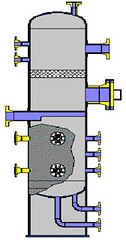In oil & gas field development, interfiled pipelines widely used to transfer well fluid from Satellite wellhead (SW) to Center Processing Platform (CPP) for pretreatment, conditioning and processing. Partial conditioned gas and partial stabilized condensate will then transfer to onshore plant via pipeline for further processing. Byproduct or waste such as produced water, Mercury, sand, etc are generally removed at CPP. Produced and Mercury will be injected back to reservoir for proper disposal. Collected sand which contaminated with hydrocarbon, mercury, etc will be send to onshore for treatment prior to sand filled.
Slugging
Partial conditioned gas and partial stabilized condensate travel through long distance pipeline will experience frictional loss and heat loss to ambient. These results change in equilibrium state and lead to condensate formation for partial conditioned gas and flashing in partial stabilized condensate. Two phase gas-liquid flow along pipeline will leads to unavoidable non-stable operation e.g. slugging flow.
Hydrodynamic Slugs
Shift in equilibrium results liquid formation or flashing and subsequently leads to slug formation, this type of slugs called Hydrodynamic slugs. Apart, there are other way / operation will results slugs formation.
Terrain Induced Slugs
Slug caused by accumulation and periodic pushing of liquid column along pipeline is called Terrain Induced Slugs. This kind of slug generally observed in severe undulation pipeline and low flow operation.
Flow Induced Slugs
Low flow operation leads to liquid accumulation in the seabed. During production ramp-up, high gas flow force liquid holdup in the pipeline towards receiving facilities. Big slug may form if improper operation of ramp-up activities.
Operational Induced Slugs
Pipeline inspection and maintenance is part of the frequent activity for any pipeline. Pigging will be the general activity to carry pipeline inspection and removal of liquid holdup, debris, sand, mercury, etc accumulated in the pipeline. Severe slugging may occurred during pigging if the pigging activity is improperly managed.
As slug approaching receiving facilities, slug size will grow. Large slug arrived at first receiver will seriously overload the liquid handling capacity and may leads to tripping of receiving facilities. Increase liquid handling capacity to handing intermittent large liquid flow may not be cost effective. Thus generally the first receiver will be designed to temporary store the intermittent slug and it will be treated after the slugging period. This receiver generally called Slug catcher.
Slug catcher is a device normally to carry bulk separation and to temporary store big slugs. There are few types of slug catchers have been designed. The following is a listing of types of slug catcher :
a) Horizontal separator type
b) Vertical separator type
c) Finger type
d) Slug Stabilizer type
Type (a) & (b) are essentially same as conventional horizontal and vertical slug catcher but with built-in slug handling capability.

Horizontal type

Vertical type
Following images show typical finger type and slug stabilizer type slug catcher :


No comments:
Post a Comment